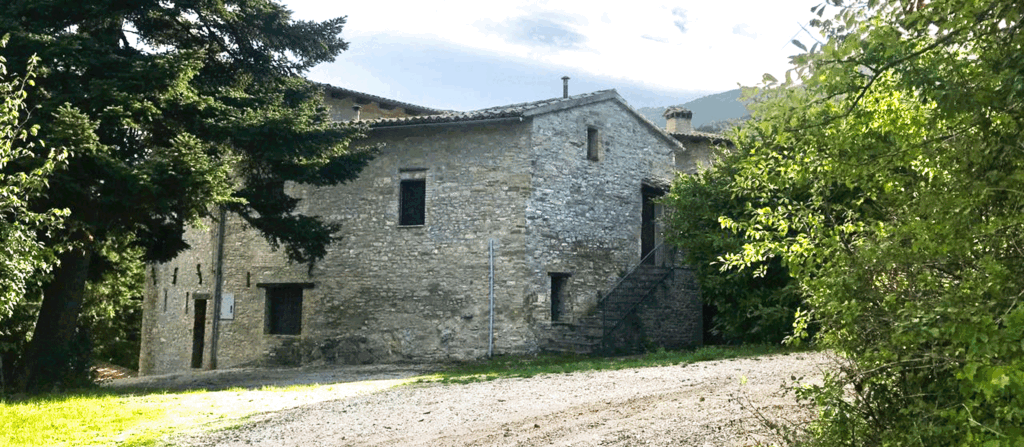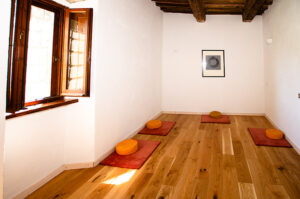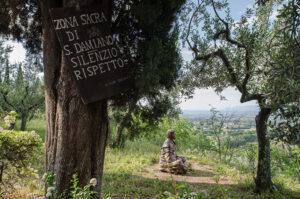IT | DE | EN

The Piccolo Castello in Nottiano
Nottiano is a medieval hamlet at the foot of Mount Subasio near the Umbrian town of Assisi, near Perugia. It would have been completely forgotten after the severe earthquake of 1997, which turned most of the houses into ruins if it had not been for the story of St. Francis, who wrote a chapter among the ancient walls. Francis, who had begun an unusual path of radical devotion to Christ in Assisi, visited the people here. He was a friend of the count who watched over the area and often stopped in to see him. A young farmer’s son from the village, Giovanni, adored the man from Assisi with such devotion that he left his family, joined the cooperative, and – to his mother’s displeasure – brought an ox from the field to Francis as a gift. Francis gladly accepted the young Giovanni into his community and returned the ox to the family.
Except for the old chapel and a festival celebrated yearly in memory of the young man, nothing reminds us of the story. But the atmosphere of the saint has never wholly left the place. Hermits lived here in silence and contemplation and stood by the people from the surrounding area with advice. Pilgrimage groups from Germany and Austria visited Nottiano. They found accommodation in the complex of buildings that we now call Piccolo Castello. The Morra family lived here, who inspired by the spiritual teacher Carlo Caretto, lived nearby Spello and maintained a center there. They bought the house to make it available to pilgrims coming to Assisi or Spello to seek spiritual nourishment. For some time, a community of the „Little Brothers“ inhabited the rooms, a religious community to which Carlo Caretto also belonged.

Since March 2023, the house has been in the care of Solveig Thorwart and Damiano Nöthen. Both live with their two sons on the mountain farm „Terra Buona“ very close by. At the end of 2016, they took over this place with olive trees, forests, and a vegetable garden, carried by the vision to bring people to live retreats in silence and mindfulness, with shared work, meditation, and honest exchange. However, over the years, it became apparent that family life, the multitude of tasks, and the space situation were difficult to reconcile with the idea of a retreat center, so the concept had to change. Nevertheless, the vision remained alive: A center for people who are searching, a house where seminars can take place, a place of welcome where people can retreat for a while from everyday business and rediscover their connection with the divine, with the earth, with themselves..
In beautiful ways, the Castello of Nottiano offered itself as the realization of the vision that for decades has been waiting with Solveig and Damiano to be born into the world. Now the gate has opened. People are invited to stop, pause and enjoy being in the present moment in the simplicity of this medieval building, surrounded by nature and sustained by silence.
The Piccolo Castello has 6 guest rooms, each sleeping 2 – 4 people. For guests on retreat, the rooms are occupied as single rooms. A large kitchen is available, which can be stocked with food upon request. In addition, there is a meditation room with a wooden floor, a seminar room, and a chapel that can be used during the stay.
Leaving the solid stone walls of the old building, the Umbrian countryside welcomes you with its beauty. In the distance, on a clear day, the peaks of the Sicilian mountains appear, still covered with snow in spring. Hiking trails lead uphill to the heights of the Monte Subasio Natural Park, and nearby, idyllic places in meadows and under trees tempt you to rest your soul and body in the world’s silence.

After twenty minutes by car, you pass one of the gates of Assisi. The city on the hill, already inhabited in Roman times, of which stone testimonies still tell, has received fame from Francesco Bernardone, the „little poor“ as his contemporaries tenderly called him. He was like a flower that gave off the fragrance of love for the little ones and the poor in the harsh days of the Middle Ages. He dared to leave the conventions of a narrowly designed professional society to follow fully his dream of closeness to Christ.
To this day, he inspires people to remember their true nature, to surrender to the Creator, and to see in all living beings their own sisters and brothers. A trip to the places of his work can be rewarding. There his spirit is alive and tangible by the people who open themselves to the mystery.
















